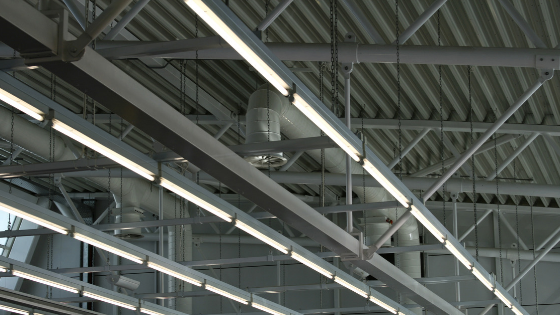When it comes to the workplace, lighting is as much a matter of safety as it is a matter of practicality. Proper lighting protects your workers from eye strain and keeps them safe from accidents.
Imagine trying to run a construction site where your workers couldn’t see what they were doing. It would be a hospital visit and a lawsuit waiting to happen.
The Occupational Safety and Health Administration (OSHA) is responsible for ensuring workplace safety, including issues related to lighting. Here, we’re covering OSHA lighting standards related to general industry companies.
What Is a Foot Candle?
First, you should understand what a foot candle is, as this is OSHA’s preferred unit of measurement.
A foot-candle is the most common unit of measurement used by lighting professionals. It refers to the illuminance of one square-foot surface from a uniform source of light. Title 29 of the Code of Federal Regulations, section 1926.56, sets out the candle-feet of light required for various types of work.
General Lighting Requirements
As a rule, generalized lighting should be evenly distributed through the workplace, without gaps, so that workers can comfortably see and move throughout the workplace without straining their eyes.
OSHA provides candle-feet breakdowns for various types of work as follows:
- First-aid stations, offices, and infirmaries: 30 foot-candles
- General construction plants and shops: 10 foot-candles
- General construction area: 5 foot-candles
- Warehouses, walkways, corridors, exits, and other indoor spaces: 5 foot-candles
- General underground work areas, including shafts and tunnels: 5 foot-candles
- Concrete placement, waste areas, loading platforms, active storage areas, field maintenance areas, refueling areas, and excavation sites: 3 foot-candles
Underground work areas do have one exception. When drilling, mucking, and scaling is performed, 10 foot-candles are required. This lighting can usually be achieved with overhead lights, though there are cases when other forms of lighting are permitted, such as cap lights in mines.
Installation Requirements and Outlets
OSHA standard 1910.305 governs installation requirements for lighting implements.
Unless otherwise specified, the rules set out for permanent light fixtures also apply to temporary fixtures. Any grounding conductors should be safely grounded where necessary. No wiring systems of any kind should be installed in ducts used to transport dust or flammable vapors.
Most restrictions on temporary lighting apply to implements under 600 volts. These can only be used in remodeling, repair, emergency work, or similar tasks.
Task and Emergency Lighting
This brings us to task lighting and emergency lighting.
Task lighting is lighting aimed at a specific area to assist in a specific job. In most cases, OSHA accepts employers following standards set in the American National Standard A11.1-1965, R1970, Practice for Industrial Lighting.
Standard 1910 governs the use of emergency lighting (i.e. lighting from a reserve source, triggered when general lighting becomes unavailable due to power failure).
The good news is that most of the same rules that apply to general lighting also apply to emergency lighting. The one exception is that temporary electrical installations of more than 600 volts may only be used in emergency situations, tests, or temporary construction activities.
Complying with OSHA Lighting Standards
We know that compliance with OSHA lighting standards is about more than protecting your bottom line. It’s about keeping your workers safe so that they can go home each day to their families.
But when you’re managing so many resources at once, it can be difficult to keep track of your compliance tasks. That’s where we can help. We provide software that makes it easy for employers just like you to meet challenges head-on and stay on top of the latest regulatory changes. Better yet, we help you streamline your whole process in one place.
Ready to build a smarter, safer workplace? Use our contact page to get in touch.
